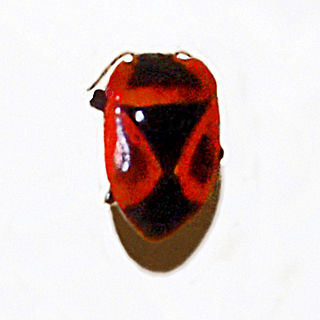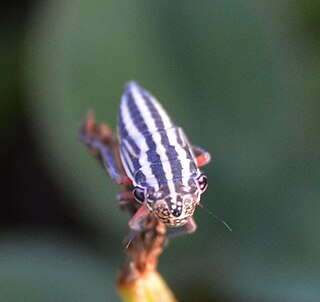
Podocarpus costalis, locally known as arius, is a species of conifer in the family Podocarpaceae. It is native to the Philippines and Taiwan.

Eusthenia is a genus of stonefly in the family Eustheniidae. It is endemic to Australia, with most species native to Tasmania.

Hypsopygia costalis, the gold triangle or clover hay moth, is a species of moth of the family Pyralidae. It was described by Johan Christian Fabricius in 1775 and is found in Europe. The wingspan is 16–23 mm. The adult moths fly from May to July, depending on the location. The supposed species H. aurotaenialis is included here pending further study.

Austrophlebia costalis, the southern giant darner, is a species of dragonfly in the family Telephlebiidae endemic to eastern Australia.

Diacrita costalis is a species of ulidiid or picture-winged fly in the genus Diacrita of the family Tephritidae.
Megalaemyia costalis is a species of ulidiid or picture-winged fly in the genus Megalaemyia of the family Tephritidae.

Margarites is a genus of sea snails, marine gastropod mollusks in the family Margaritidae.

Calluga costalis is a moth of the family Geometridae. The species was first described by Frederic Moore in 1887. It is found in Sri Lanka, Taiwan, Borneo, Bali, Sulawesi, Seram, New Guinea and Queensland.

Dismegistus is a genus of true bugs belonging to the family Parastrachiidae.

Cuerna is a genus of sharpshooters in the family Cicadellidae. There are 26 species in this genus. They can be found in North America from Canada and Alaska to Panama, but the highest diversity of species is in the southwestern United States.

Metoxypilus costalis is a species of praying mantis in the family Nanomantidae.
Ortalis is an historic genus of Ulidiid or picture-winged flies, first described by Fallén in 1810. It served as the type genus for the family Ulidiidae, which was called Ortalidae at the time. In 1932, it was pointed out by Adlrich that the name Ortalis was preoccupied by a genus of birds which had been named by Merrem in 1786. The name of the fly family was therefore revised, with some authors calling it Otitidae until Ulidiidae was settled on as standard. The genus itself was found to be paraphyletic, and all of its species have been reassigned to other genera, some in the Ulidiidae, and some in other Tephritoid families. In the following list, the species are organized according to the families and genera to which they have been reassigned.
Encoptolophus costalis, known generally as the western clouded grasshopper or dusky grasshopper, is a species of band-winged grasshopper in the family Acrididae. It is found in Central America and North America.

Thoracophorus costalis, the furrowed rove beetle, is a species of unmargined rove beetle in the family Staphylinidae. It is found in Central America and North America.

Epitheca costalis, known generally as the slender baskettail or stripe-winged baskettail, is a species of emerald dragonfly in the family Corduliidae. It is found in North America.

Stelis costalis is a species of cuckoo bee in the family Megachilidae. It is found in Central America and North America.
Tmesiphorus costalis is a species of ant-loving beetle in the family Staphylinidae. It is found in North America.
Zeridoneus costalis is a species of dirt-colored seed bug in the family Rhyparochromidae. It is found in North America.
Zeridoneus is a genus of dirt-colored seed bugs in the family Rhyparochromidae. There are at least three described species in Zeridoneus.
Hoplisoides costalis is a species of sand wasp in the family Crabronidae. It is found in Central America and North America.













